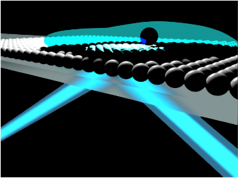
HOME / Departments / Chemistry / Nanomaterials and Interfaces
Nanomaterials and Interfaces
-
- TAMADA Kaoru, Professor ◎
- ARIMA Yusuke, Associate Professor ◎
- KAJINO Yuto, Assistant Professor ◎
- ◎ Institute for Materials Chemistry and Engineering
- Our group studies about the interfacial phenomena between metals, metal oxides, semiconductors and soft materials in nanoscale. Our research target is not only to investigate new physicochemical phenomena on cutting edge of interdisciplinary field of science, but also to develop the new concept for future green and bio-technologies. Our topics include (1) Collective plasmon excitation on 2D crystalline sheets composed of Au and Ag nanoparticles, (2) High sensitive biosensor and high resolution bioimaging by use of localized surface plasmons, (3) Surface plasmon enhanced optoelectric devices such as light-emitting diodes (LEDs) and photovoltaic cells.
Nano-plasmonics of metal nanoparticles

We work on unique plasmonic characteristics of two dimensional (2D) crystalline sheets composed of homogeneous metal nanoparticles fabricated by the Langmuir–Schaefer method at an air–water interface (Left). The localized surface plasmon resonance (LSPR) band of the metal nanoparticle sheets could be tuned by changing the interparticle distance between the self-assembled particles, and also the number of the stratified layers on metal substrate (Center). The significant reflective color originates from multiple light trapping in the stratified sheets that has a metamaterial characteristic along with an intra-layer and inter-layer coupling of localized surface plasmon resonance (LSPR).
Applications using the metal nanoparticle sheets

The plasmon colors described above was applied to a naked-eye detection of biomolecules. For example, only a small number of adsorbed Au nanoparticles via biotin-avidin interaction could change a reflection color of a probe surface completely. The confine light at nanointerface by the nanoparticle sheet (ca. ~ 20 nm) was also utilized for high resolution imaging of cell attached interface under TIRF microscope.
Applications of plasmonics for high-efficiency light emitters

One futuristic application of plasmonics is the development of high-efficiency light-emitting materials and devices. We have succeeded in increasing the emission efficiencies of nitride semiconductor materials by using the surface plasmon coupling with metal nanostructures. This technic is expected to lead to a new class of super bright and high-speed LEDs that offer realistic alternatives to conventional fluorescent light sources.